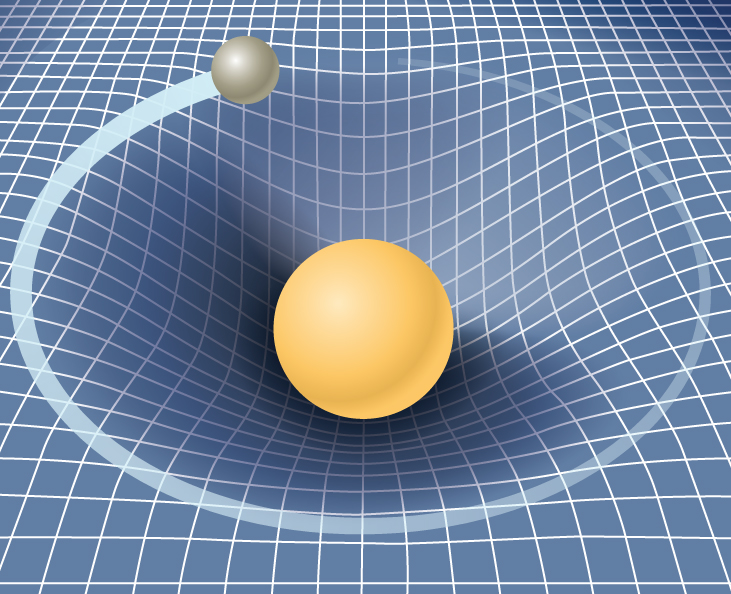Think of the universe as a painting. There’s the image made in paint, and the surface it was painted on. The canvas.
The stars, the planets, the gasses, the matter and energy and even the space between are the paint. What’s the canvas? Is there a canvas? Would the canvas follow the same rules as the paint?
I believe what you are looking for is spacetime which is the foundation that all of the universe exists on. My layman’s understanding is that objects with mass “curve” or “bend” spacetime around them and this is actually how gravity effects objects. An object moving along a straight path (from it’s perspective if on a small enough scale) which is actually following a curved path of spacetime will move in a curved path.

This gives a visual representation of the curving of spacetime.

This shows how a super massive object like a white dwarf or black hole distorts and eventually “breaks” spacetime.
This video also shows it visually fairly well.
Excellent comment, love the diagrams.
But we know spacetime is getting bigger, because the universe is expanding. So what is spacetime expanding into?
Who knows? Are we in a bubble floating in a higher dimensional sea of different bubbles? Is it nothing, like a balloon expanding in the vacuum of space?
As i understand it it (somewhere between barely and not at all) the idea is not that It’s “expanding” in the sense of a balloon inflating into the space around it.
Its more stretching internally.So the distance (or time it would take at constant speed) between any 2 points is geting bigger.
You could maybe also say it’d take more energy to move between the points in a set time.There’s probably nothing outside, but the distances inside get longer.
It’s probably something to go with gravity, momentum and entropy. The actual concept of “distance” between things might not be what we think.
But all these theories give rise to the concet of large amounts ob unobserved ‘dark’ mattter and evergy, so the actual basis of currently observable fact (i.e. energy / mass) is a small fraction of what is needed for these theories to work.
How do quantum physics play with spacetime?
I’m probably not asking the right question for what I mean… For context into my own thoughts process here, I originally thought of the question when reading a science post on quantum physics vs general relativity and how they don’t mesh and wondered “could we be seeing the medium simply behaving differently than the art?”
My understanding is that quantum physics is the study of the incredibly small, and general and special relativity are the study of everything else. They don’t overlap (rules for big don’t work for small, and vice versa) and are two separate understandings. Which is why the, hopefully, next big thing will be a unifying theory that applies to everything. I believe Stephen Hawking was a well known scientist working on finding a universal theory.
Which doesn’t really answer your question, but it’s a question far surpassing my knowledge. I think quantum mechanics just doesn’t interact with spacetime, or at least not in a meaningful way (mass of an electron is so incredibly small it isn’t perceptively effected by spacetime curves).
I would be happy for someone with more knowledge to come and prove me wrong though, these are fascinating fields.
Special relativity definitely overlaps with quantum mechanics and that overlap forms the basis of the math used at collider experiments like those at the LHC. Special relativity is simple with 2 rules that let you derive all the equations: 1) no universal reference frames 2) speed of light is constant.
You’re probably thinking about general relativity which defines gravity through the curvature of space time.
If you think about quantum mechanics existing on some “canvas”, that might look like an interlocking mesh of springs (like something under a bed or cot). You could take your hand and bounces it up and down on this mesh, adding oscillations and creating standing waves in the grid. These oscillations would be different particles (electrons, protons) each with their own characteristic frequency of oscillations. If you add energy to the bed of springs, you can “pop” particles into existence. All these particles actually are are just excitations of the mesh/canvas. As of yet, there’s been no way to define or find the gravity particle on this canvas, so right now the canvas of space time and the canvas of quantum mechanics are two distinct “things”.
Well, I am pleasantly proven wrong, thanks! Yes, I was thinking of general relativity, you are correct.
These oscillations would be different particles (electrons, protons)
Are you saying that the particles are oscillating in reaction to your hand bouncing the mesh, like a handful of marbles on a bed bouncing around? What constitutes a “hand push” in the real world? A high energy collision like at the LHC? Or day to day interactions between objects?
This is very fascinating, although I can’t help but see a similarity between the two canvases. Is that just because they are both so complex that we need simple analogies to try and wrap our heads around the concepts?
No, the analogy is more that the oscillations are themselves the particles.
The addition of energy into a system would be this hand push. The fact that the particles themselves exist means that they are oscillations in this mesh (with some energy/frequency). Interactions with other particles can add or remove energy.
Definitely these canvas metaphor are just conveniences. Also, I got it from Zee’s “Quantum Field Theory in a Nutshell” which is a standard graduate or advanced undergrad level book on QFT.
That is the key to almost everything. Quantum mechanics is neat and tidy. Space time is neat and tidy. They don’t play well with each other, though. Some scientists say that we need to figure out dark matter and dark energy to make them play together. Others say they are so incompatible that we need new science altogether to figure it out.
In the first picture, the object in orbit is travelling along, say, y=0. There could also be an object in orbit along x=0, right? So that would mean there isn’t a “canvas” or 2D equivalent, since things can orbit at any angle. Is that right?
The ‘canvas’ which everything else resides upon is currently thought to be Quantum Fields: Quantum Fields: The Real Building Blocks of the Universe - with David Tong. (A 1h video by a theoretical particle physicist that’s in layman’s term, very educational and downright LOL funny at times. Well worth your time!)
A Field is something that permeates the entire universe. There’s thought to be a field for every particle in the Standard Model. Electron, photon, charm, up, etc. A particle forms when the field is excited, and these particles interact with each other to form the universe.
Dark energy…maybe. Unfortunately scientists don’t really know what it is or if it even exists. It’s somewhat controversial, but theoretical/mathematical indirect evidence points to the possibility. Sabine Hossenfelder on YouTube can explain this stuff far more intelligently and in more detail than I can.
One thing I try to keep in mind is: the observable universe is unfathomably vast… but that’s just the stuff we can detect with instruments. The “canvas” could easily exist beyond our limited abilities to measure or comprehend.
While I think I know what you mean when you say “canvas”, a physicist would probably want a more specific question. It could get into string theory and all kinds of weird stuff that’s way beyond my knowledge.
The universe is an imbalance of humors within the aether.
It sure does feel like there isn’t enough humor in the aether.
The universe IS the canvas. Everything else that was added to it (stars, planets, supernovas, black holes, gases, etc) is the paint.
There might be a copy of this canvas, but we can’t know unless someone manages to prove that you can travel between universes. And even then, it’s likely just either our universe with very small but effective modifications, or it’s a segment of our imagination.
Well if you think of our universe as a flat image, you could technically picture it as an ever expanding “canvas” ,like the reddit and lemmy thing, and as all the other planets and stars change and move so does that magical canvas of the universe.
You may want to look up “event horizon”.
Great movie.
Removed by mod
I don’t know. It’s seemed fine to me. :)
What’s simple to some people may not be as simple to others. That’s why this community exists.
This is more like a question someone who ate too many pot brownies asks. It’s not deep.
The question hits on some of the most fundamental aspects of our current understanding of reality and theoretical physics. As another commenter pointed out, one potential answer delves into QFT. Just because OP used a metaphor doesn’t warrant you saying they had “too many pot brownies” and there’s absolutely no need to be a condescending jerk here.
I agree completely. As someone who’s fascinated with cosmology, I think this is a perfectly reasonable question and a perfect fit for this community.
Lol came here to say something similar.
There may not be stupid questions but there are stupid comments.







